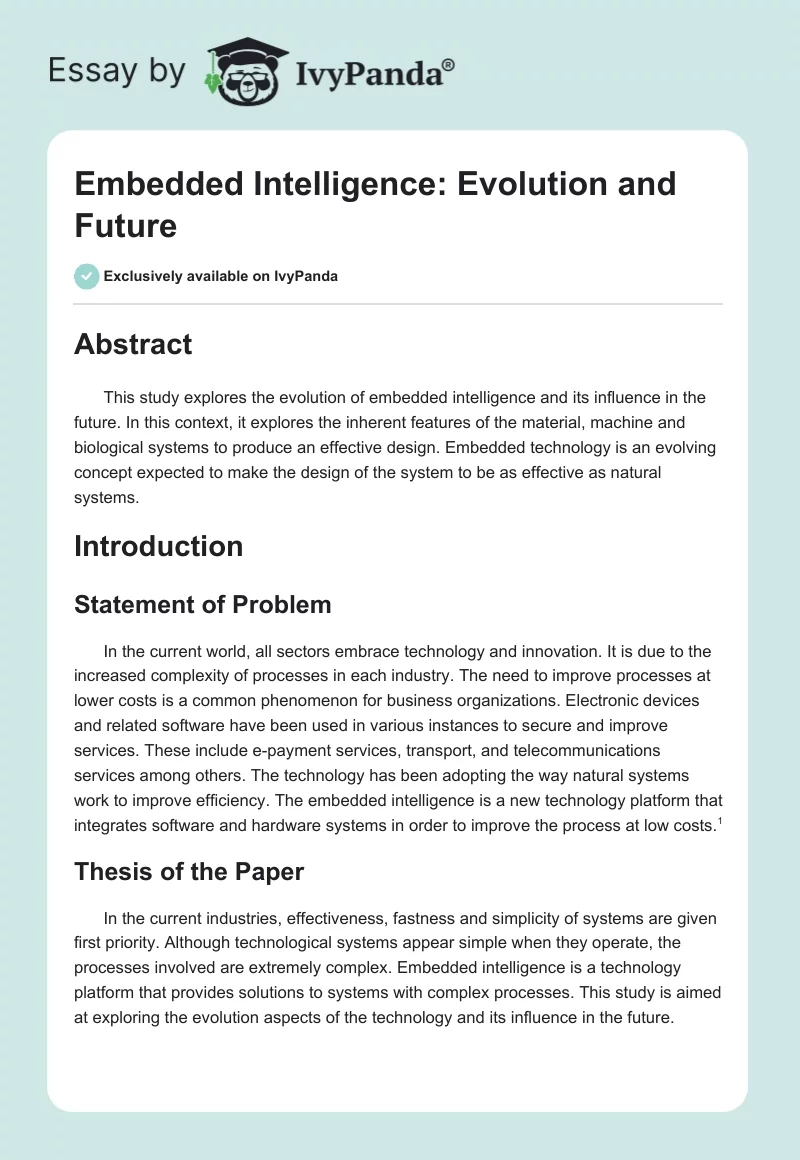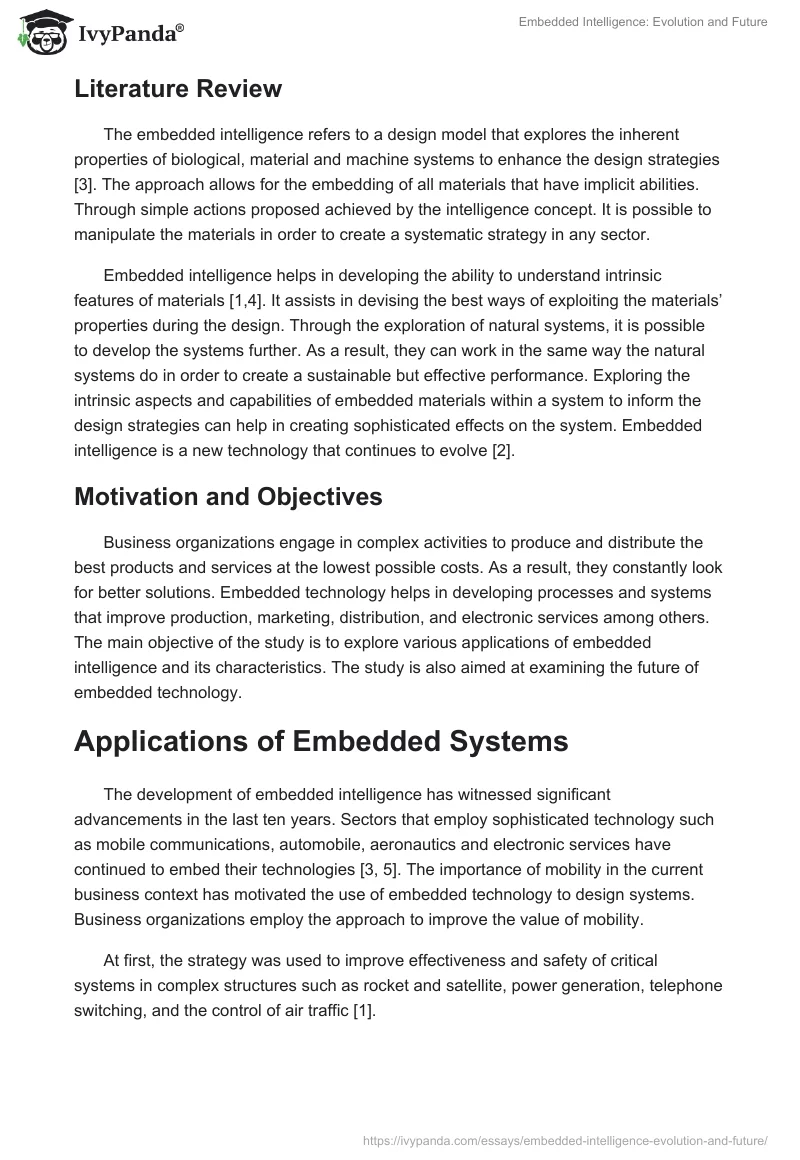Abstract
This study explores the evolution of embedded intelligence and its influence in the future. In this context, it explores the inherent features of the material, machine and biological systems to produce an effective design. Embedded technology is an evolving concept expected to make the design of the system to be as effective as natural systems.
Introduction
Statement of Problem
In the current world, all sectors embrace technology and innovation. It is due to the increased complexity of processes in each industry. The need to improve processes at lower costs is a common phenomenon for business organizations. Electronic devices and related software have been used in various instances to secure and improve services. These include e-payment services, transport, and telecommunications services among others.
The technology has been adopting the way natural systems work to improve efficiency. The embedded intelligence is a new technology platform that integrates software and hardware systems in order to improve the process at low costs.
Thesis of the Paper
In the current industries, effectiveness, fastness and simplicity of systems are given first priority. Although technological systems appear simple when they operate, the processes involved are extremely complex. Embedded intelligence is a technology platform that provides solutions to systems with complex processes. This study is aimed at exploring the evolution aspects of the technology and its influence in the future.
Literature Review
The embedded intelligence refers to a design model that explores the inherent properties of biological, material and machine systems to enhance the design strategies. The approach allows for the embedding of all materials that have implicit abilities. Through simple actions proposed achieved by the intelligence concept. It is possible to manipulate the materials in order to create a systematic strategy in any sector.
Embedded intelligence helps in developing the ability to understand intrinsic features of materials. It assists in devising the best ways of exploiting the materials’ properties during the design. Through the exploration of natural systems, it is possible to develop the systems further. As a result, they can work in the same way the natural systems do in order to create a sustainable but effective performance. Exploring the intrinsic aspects and capabilities of embedded materials within a system to inform the design strategies can help in creating sophisticated effects on the system. Embedded intelligence is a new technology that continues to evolve.
Motivation and Objectives
Business organizations engage in complex activities to produce and distribute the best products and services at the lowest possible costs. As a result, they constantly look for better solutions. Embedded technology helps in developing processes and systems that improve production, marketing, distribution, and electronic services among others. The main objective of the study is to explore various applications of embedded intelligence and its characteristics. The study is also aimed at examining the future of embedded technology.
Applications of Embedded Systems
The development of embedded intelligence has witnessed significant advancements in the last ten years. Sectors that employ sophisticated technology such as mobile communications, automobile, aeronautics and electronic services have continued to embed their technologies. The importance of mobility in the current business context has motivated the use of embedded technology to design systems. Business organizations employ the approach to improve the value of mobility.
At first, the strategy was used to improve effectiveness and safety of critical systems in complex structures such as rocket and satellite, power generation, telephone switching, and the control of air traffic.
In the current context, the research and development of embedded systems focus on the design of complex and advanced products. Several countries have adopted the embedded intelligence in their transport systems through trains, automotive, spacecraft, and avionics. However, components that are the true interface of embedded systems for common consumption include cameras, cellular phones, televisions and audio systems among others. The advanced use of embedded intelligence occurs in five main circumstances. It is employed in controlling complex processes such as energy production, industrial automation, distribution, and optimization.
Embedded components are used to design telecommunications systems such as mobile devices, satellites, and network systems. It is used in the management of energy systems such as production, distribution, and optimization. Security of e-commerce and electronic services such as smart cards apply the technology. Health is another sector that uses embedded technology to design hospital equipment, enhance mobile clinic and monitoring systems.
In the past few years, individuals and organizations have been using the technology to achieve feasibility. Nevertheless, the latest trend in embedded intelligence focuses on the optimization of designs to achieve better outcomes. Businesses use it to capture huge market shares in their segments at the lowest cost within the shortest time. For instance, seamless integration with the electronic and physical contexts has improved service delivery in many sectors. Its benefits have resulted from the ability of the technology to understand practical constraints such as strict deadlines, costs, availability, reliability, power consumptions, and robustness among others.
Automobile Sector
The automobile is the leading sector in the acquisition and utilization of the embedded intelligence to manufacture energy-efficient electric motors. They comprise ordinary DC motors, brushless DC motors and inductors that employ controllers in their operations. The automobile industry in Europe has intensified the application of embedded technology in order to improve the control of automobile engines.
They are using the latest embedded innovations to develop automobile parts such as wired-breaking and wired-driving systems. The technology finds its immediate application in the manufacturing of electric and hybrid automobiles. In this context, its use enhances effectiveness and reduces pollution. The embedded intelligence has helped firms in the industry to develop various safety systems for vehicles. They consist of antilock-braking systems, control systems for traction, electronic steadiness, and automated four-wheeled vehicles.
Aerospace and Avionics
The sector uses complex systems that include the integrated electronic and hardware systems. To improve their efficiency, they integrate those systems with embedded software. Engineers and technocrats in the field face several challenges. They need to create an embedded system within the stated time and take into consideration the cost-related constraints. It is a challenge to ensure that complex software and hardware components interact in the right way.
It is difficult to assemble components that meet the design specifications and have efficient performance. Another challenge is the understanding of the larger view of the embedded intelligence. Engineers and technicians have difficulty in adopting the latest technology of embedded intelligence such as the fly-by-wire technology.
Telecommunications
The industry that benefitted the most from the embedded technology is Telecommunications. It uses several embedded components and systems such as telephone switches, network components, and mobile devices. Through the network routing system, computerized telecommunication systems use the embedded technology to improve networks and traffic. Using embedded technology in telecommunication network designs assists in creating high-speed network systems. It helps in designing Ethernet switches and network interfaces that provide the required bandwidth. Using highly developed embedded applications enhances rapid Ethernet connections.
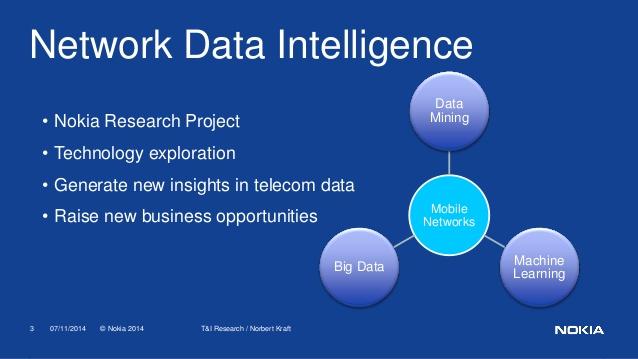
Consumer Electronic Devices
Consumer products are the most used goods all over the world. The consumer electronic products have also gained many benefits from the embedded intelligence and related technologies. These include smartphones, tablets, audio and visual players, digital cameras, and other components. Other consumer electronic devices are laundry machines, cooking devices, and other domestic devices. All these are manufactured using embedded technology.
For instance, companies such as HVAC apply the technology to create networked thermostats. Embedded thermostats demonstrate effective control of temperatures. In the current context, automation of domestic solutions continues to use embedded intelligence. These include the wireless and wired networks used to control audio and visual systems, lights, surveillance and temperature. They use embedded sensing and controlling components.
Railroad
The current railroads are more sophisticated than the traditional railways. Railroad signals in Europe heavily rely on embedded systems, which enhance a safe control of fast and heavy traffic. Embedded technology has improved the manner in which railroad signals control large and fast traffic. Consequently, it improves the safety of railroad equipment and vessels, especially when adopted across the global networks. The systems help in reducing the number of rail accidents and disasters.
E-Payment Solutions
In the current business environment, firms compete for embedded solutions to improve their services. Electronic payment systems are among the platforms firms adopt to enhance fast and secure online money transfer. The modern engineers and experts in the field of embedded intelligence create secure and encrypted payment systems for international financial institutions. The technology allows for the fast and secure transfer of money across the world through an online platform.
The current market for mobile money transfer is developing at a rapid rate. Large, medium and small businesses prefer mobile and online money transfer as a way of transacting businesses with customers. The universal adoption of mobile devices has also encouraged people to use electronic payment solutions. Embedded technology is compatible with the modern mobile devices. The situation encourages the application of embedded intelligence to promote e-payments.
Smart Cards
The initially produced cards were either a credit card or a debit card. The technology has developed gradually into the current smartcards. The cards have personal identification details of their holders. They have an entitlement scheme that takes national, regional or international standards. Smart cards have found their usage in various sectors. They are now used as national identification cards, patient cards, master cards and drivers’ license.
Smart Agriculture
Agriculture is one of the main fields that require technology to increase productivity and quality of farm produces. Farming involves complex activities that can create confusion if they are not integrated effectively. For instance, a farmer needs to understand climatic conditions and trends in order adjust farming practices. In addition, changes in soil conditions can lead to changes in farming practices.
Using modern technology and computing techniques can help in improving farming activities. Embedded technology can help in optimizing the farm management strategy by maximizing outputs while keeping inputs at the minimum levels. A cloud based embedded platform will be able to take weather information from satellites and suggests the best farming practices for a farmer. In the far future, an embedded farming system will remove the human labor. Instead, it will set up robotic farm equipment such as sensor-based cultivators and irrigators to do farming practices.
Components of an Embedded System
In its basic terms, an embedded system refers to a computerized device designed with the aim of performing specific tasks. In many cases, the tasks they perform are based on real-time control of processes. Compared to other structures, embedded systems are cheaper and easier to control. The main challenge is faced during the design and production of its components. The four major components of an embedded system are the processor, memory, clock system and peripheral devices.
Processor
The processor is the main part of the embedded system because it acts as the controlling unit. It takes the role of a generic microcontroller or a computer microprocessor. Systems perform different tasks depending on the industry and specific need for which they are made. Therefore, a processor is programmed to execute specific tasks. They are then integrated with the other components to allow the system perform specific duties.
Memory
Another important component of an embedded system is the electronic memory. The device is used to store information that can be retrieved when analyzing the conditions of the system. The three types of memory include RAM, ROM, and Cache. The RAM is an acronym that stands for random access memory. On the other hand, the ROM refers to the read-only memory. The system data is stored temporarily in the RAM. The data stored in the RAM are used when the system execute tasks.
On the other hand, the ROM has an input-output characteristic, which is necessary for the system to boot. During the processing and transfer of data, a processor needs a storage system. To ensure an efficient processing of data and execution of duties, the cache stores the microprocessor’s information.
System Clock
The clock system is used to ensure that all processes within the embedded system are executed correctly. In this context, the most important factor is the timing of the processes. The system clock consists of an oscillator and other digital circuit components. The components used to design the clock are embedded in order to improve the timing of processes executed by the system.
Peripheral Systems
Peripheral systems comprise of devices that perform specific tasks assigned to them. The assignment of the task is performed when programming the embedded component. The peripheral devices are integrated with the embedded structures because they have the physical ability to perform different tasks. They also help in inserting data into the software components of the system. Peripherals can also be used to execute physical control of the system. They include keyboard and mouse ports, serial and parallel ports, memory unit and monitor ports among others. Specialized devices that use embedded technology may have additional ports such as the CAN-bus.
Characteristics of embedded system
Many embedded systems are developed to execute continuous performance at the lowest possible cost. However, they face constraints in terms of software and hardware components. The inability to operate and control the system in real time at high speeds is a serious challenge. It is not easy to estimate the speed and related costs of embedded systems, especially when the work to be executed is large. The embedded components of a system have the vital features designed through the integration of hardware with high-speed software. Using a television satellite decoder as an example can be used to demonstrate the way an embedded system operates.
Even though a system is able to process several megabits of data in one second, a multi-channel system is used to enhance performance. The scenario explains why decoders receive clearer signals than the traditional television sets. Embedded processors have the ability to calculate the storage locations for the system to run smoothly. The hardware components embedded into the software must adhere to the stated standards. This ensures that the system’s productivity improves at the lowest costs. A business entity is able to offer its products and services at low prices if the cost of production and distribution is low.
Dicusiions of Possible Embedded Systems
With the advancement in the electronics sector, networking, mobile communication, artificial intelligence, and cloud computing, the interactions among devices have significantly increased. In the near future, many objects around us will depend on small processors or sensors embedded in them to communicate and perform tasks. Such a state will make live more connected and accessibility to people and things will be easy.
However, the future of embedded intelligence depends on the technology advancement, which will enable faster communication, large data storage capacity, high-speed data processing and highly interconnected devices. Before using numerous applications of the embedded technology, the following seven systems will define the future of embedded intelligence.
Ubiquitous Computing
It is a computing field that deals with interconnection and communication of hardware devices. The knowledge of ubiquitous computing is used to integrate objects we interact with in daily activities. The objects in this context can be anything that humans use to improve their lives. Mobile devices such as Smartphones and tablets are the main targets for embedded technology applications. However, it is possible to use the technology to improve the usability of other objects such as the game console.
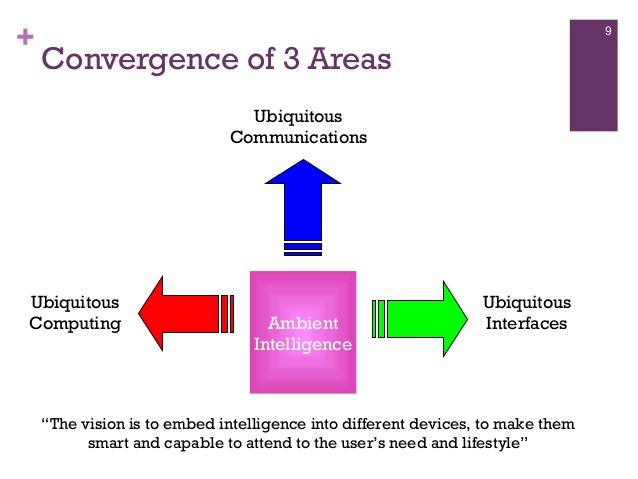
The ubiquitous computing also uses sensors to detect environmental aspects and respond to them accordingly. The application of ubiquitous computing has helped to develop devices and systems that interact with the environment in an effective manner.
With the current advancement in technology, the application of the ubiquitous computing has improved. For instance, the iCloud developed by Apple Inc. is a basic implementation of an embedded ubiquitous computing. It seamlessly integrates all devices made by Apple. It also maintains unified data of those devices. A full application of embedded technology will improve interconnectivity and data transmission speed of such devices.
Intelligence Devices
These electronic devices have cognitive abilities. They use a combination of artificial intelligence, algorithms, software and embedded hardware systems to replicate thoughts exclusive to human beings. Engineers and experts in this field are working to create an environment with devices working in the same way as natural systems. For instance, an Android controlled intelligent bulb can create various lighting contexts. A security system can also be created using embedded intelligence to detect chemical leaks or intrusion. Although such devices have been in existence for some decade, using embedded technology will enhance high-speed and real-time performance.
Internet of Things
The concept of the “Internet of Things” is the latest revolution in the technology context. The idea slowly sneaks into the human environment and it will soon become a reality. Introduced in 1989 by Kevin Ashton, the innovative idea is aimed at connecting physical objects to the internet. These include domestic appliances, office equipment, and industrial machines. The advancement in cloud computing increases access to the high-speed internet across the world, the technology concept will soon be practical.
The application of embedded intelligence to realize the “Internet of Things” technology will make fantasies become realities. For instance, a person will be able to communicate with chairs and other domestic appliances using a smartphone.
Cyber-Physical Systems
The platform is an important concept that would help in the realization of the “Internet of Things” technology. The cyber-physical systems depend on powerful computation with high-speed communications. Its objective is to integrate the physical world with the cyber systems. It intends to develop systems that perform précised tasks. For instance, a hand of a robotic can be made using the cyber-physical technology. The success of cyber-physical technology with embedded components would facilitate easier interaction between humans and objects around them. With such systems, humans will use devices to access the space with easy and gather efficient information.
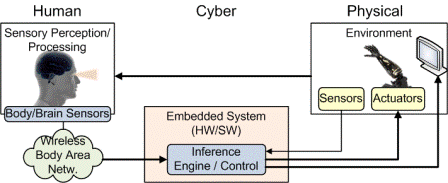
Context-Aware devices
Bill Schilit introduced the concept in the computing world in 1994. It refers to any form of information about an object or physical environment received in real time. The aim is to develop devices that detect activities within their environment at the instant they occur.
The context-aware technology is an added concept to the ubiquitous computing. By creating devices that detect activities within their environment, businesses will be able to understand the specific needs of their customers. Consequently, they will be able to respond at the right time with appropriate product or service. Embedded components such as sensors can help a transport business to understand weather conditions in an area. Such devices can help an organization to gather information within their areas of operation.
Automatic Contextual Reconfiguration
The technology develops systems that detect the environment and initiate tasks that will produce a positive response to the contextual actions. The devices use powerful automatic features to enhance contextual configuration. The phenomenon has a wide range of application in various industries. With embedded technology added to the system, it will be possible to control activities of the surrounding and those of other devices.
The idea of the context reconfiguration can be used in security systems to disable all devices that might perform unwanted tasks. Through embedded hardware and software components, businesses can use the automatic contextual reconfiguration to improve its productivity, distribution and quality of services. Such systems will eliminate the manual interventions during the execution of processes.
Organic Computing
Organic Computing systems are developed to respond to emerging situations and reconfigure themselves appropriately. They can take appropriate decisions to conform to the situations within their environments. For instance, while navigating a land terrain such systems can help transport vessels to adjust speeds. Integrating them with embedded systems would improve their abilities. The application of organic computing is still limited because of ethical and legal issues.
Conclusion and Future Work
Summary
The traditional era of industrial revolution when everything worked manually is long gone. Machines were being operated manually and everything depended on the human labor. However, the introduction of automation changed everything. Many people show the automation as a threat to employment. In the twenty-first century, things have significantly changed. The increase in complexity requires a modern technology such as embedded intelligence.
Conclusion
Technology has made everything appear simple. However, the design behind the technological success involves complex processes, which should be addressed using embedded intelligence.
The Future Work
In the past one decade, the embedded intelligence was introduced into the technology realm as a way of improving processes and services. Many sectors such as transport, avionics and spacecrafts, telecommunications, e-payments and other electronic services will require embedded technology to develop their systems.
References
S. Aciar, “Adaptive business intelligence for an open negotiation environment,” Digit. Eco. and Tech. London, vol. 9, pp. 517-522, 2009.
Y. Hayashi, “Understanding consumer heterogeneity: A business intelligence application of neural networks,” Knowl. Bas. Syst. Oxford, vol. 23, pp. 856-863, 2010.
Y. Houxing, “A knowledge management approach for real-time business intelligence; Intelligent systems and applications, (ISA),” 2nd Int. Workshop on Digit. Obj. Id. London, vol. 2, pp. 1–4, 2010.
L. Jang, and P. Sang, “Intelligent profitable customers segmentation system based on business intelligence tools,” Expert Syst. with App. London, vol. 29, pp. 145-152, 2005.
K. Rouibah et al., “Puzzle: A concept and prototype for linking business intelligence to business strategy,” The J. of Strat. Info. Syst. Oxford, vol. 11, pp. 133-152, 2002.
L. Luhao, “Supply chain integration through business intelligence: Management and service science (MASS),” Int. Conf. on Digit. Obj. Id. London, pp. 1-4, 2010.

